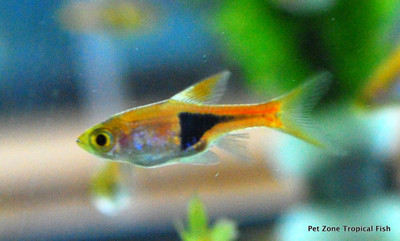Harlequin Rasbora
Posted by Max Gandara on on 17th Jul 2024
Harlequin Rasbora: The Graceful Jewel of Freshwater Aquariums
The Harlequin Rasbora (Trigonostigma heteromorpha) is a beloved and enduring favorite among freshwater aquarists. Known for their stunning coloration and peaceful nature, these small fish bring a touch of elegance and vibrancy to any community tank. In this blog, we'll explore everything you need to know about Harlequin Rasboras, including their origins, care requirements, behavior, and fascinating facts.
What Are Harlequin Rasboras?
Harlequin Rasboras are native to the slow-moving waters of Southeast Asia, particularly in Thailand, Malaysia, and Singapore. They are members of the Cyprinidae family and are widely recognized for their striking appearance and ease of care, making them a popular choice for both novice and experienced aquarists.
Appearance
Harlequin Rasboras are known for their distinctive and attractive appearance:
- Size: These fish are relatively small, reaching about 1.75 inches (4.5 cm) in length.
- Coloration: They have a beautiful metallic orange to reddish-copper body with a characteristic black triangular patch that starts near the dorsal fin and tapers down towards the caudal fin.
- Shape: They have a streamlined body with a slightly upturned mouth, which is typical of many rasboras.
Tank Requirements
Providing the right environment is crucial for the well-being of Harlequin Rasboras. Here are the key tank requirements:
Tank Size and Setup
- Tank Size: A minimum tank size of 10 gallons is recommended for a small school of Harlequin Rasboras. However, a larger tank is preferable to accommodate more individuals and create a more stable environment.
- Substrate and Decorations: Use a soft substrate like sand or fine gravel. Include plenty of plants, driftwood, and rocks to create hiding spots and mimic their natural habitat.
- Plants: Live plants are highly recommended as they provide cover, contribute to water quality, and enhance the overall aesthetics of the tank. Suitable plants include Java fern, Anubias, and various types of mosses.
Water Conditions
- Temperature: Maintain a stable water temperature between 72-81°F (22-27°C).
- pH Level: Harlequin Rasboras prefer slightly acidic to neutral water, with a pH range of 6.0-7.5.
- Hardness: They thrive in soft to moderately hard water, with a general hardness (GH) of 2-12 dGH.
Filtration and Maintenance
- Filtration: Use a gentle filtration system to keep the water clean and well-oxygenated. Harlequin Rasboras prefer calm waters, so avoid strong currents.
- Water Changes: Perform regular water changes (20-30% weekly) to maintain optimal water quality.
Diet
Harlequin Rasboras are omnivorous and require a balanced diet to stay healthy and vibrant:
- Flake and Pellet Foods: High-quality flake or micro-pellet foods should form the staple of their diet.
- Frozen and Live Foods: Supplement their diet with frozen or live foods such as daphnia, brine shrimp, and bloodworms to provide essential nutrients and encourage natural foraging behavior.
- Vegetables: Occasionally offer finely chopped vegetables like spinach or zucchini for added variety.
Behavior and Compatibility
Harlequin Rasboras are peaceful and active fish that thrive in a community setting. They are best kept in schools of at least six to eight individuals, as they are social and exhibit schooling behavior. Suitable tank mates include:
- Other small, peaceful fish such as tetras, guppies, and dwarf gouramis
- Dwarf shrimp
- Small, non-aggressive bottom-dwellers like Corydoras catfish and Otocinclus
Avoid housing them with large or aggressive species that may intimidate or prey on them.
Breeding Harlequin Rasboras
Breeding Harlequin Rasboras in captivity is possible and can be a rewarding experience:
- Tank Setup: Provide a separate breeding tank with fine-leaved plants or spawning mops for the female to lay eggs on.
- Water Conditions: Maintain optimal water quality and stable parameters to encourage breeding behavior.
- Diet: Feed the breeding pair a nutritious and varied diet to ensure their health and readiness to spawn.
Females will scatter their eggs among the plants, and the fry will hatch within a few days. Provide suitable conditions for the fry to grow, including infusoria or finely crushed flake food.
Interesting Facts
- Longstanding Popularity: Harlequin Rasboras have been popular in the aquarium hobby for decades due to their beauty and ease of care.
- Peaceful Nature: Their gentle and peaceful demeanor makes them ideal for community tanks, where they coexist harmoniously with a variety of other species.
- Schooling Behavior: Harlequin Rasboras are known for their schooling behavior, often swimming together in tight, synchronized groups, which adds dynamic movement to the aquarium.
Harlequin Rasboras are a delightful and captivating addition to any freshwater aquarium. Their vibrant colors, peaceful nature, and intriguing behavior make them a favorite among aquarists. By providing the right environment, diet, and tank mates, you can enjoy the beauty and charm of these fish for many years. Whether you're a beginner or an experienced fish keeper, Harlequin Rasboras are sure to enhance the beauty and tranquility of your aquatic ecosystem.

